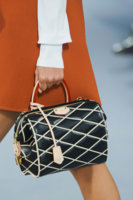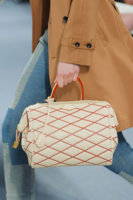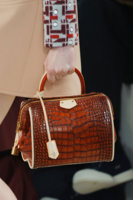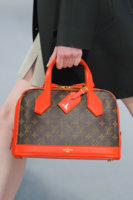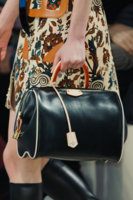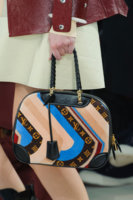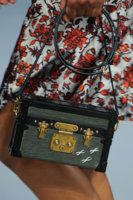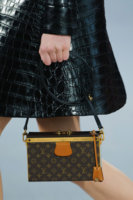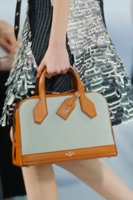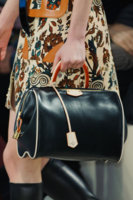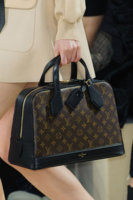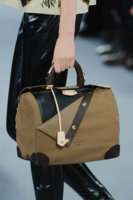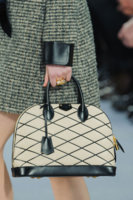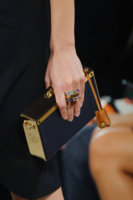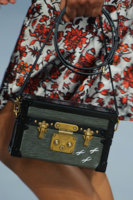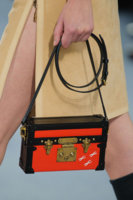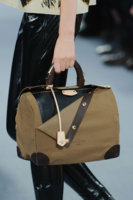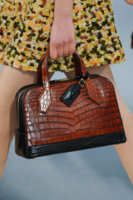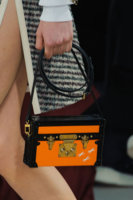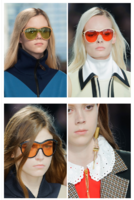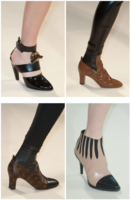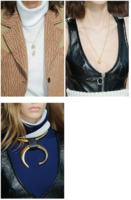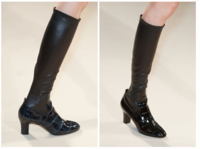You are using an out of date browser. It may not display this or other websites correctly.
You should upgrade or use an alternative browser.
You should upgrade or use an alternative browser.
Louis vuitton womens fw 2014-15 fashion show
- Thread starter SANDER
- Start date
More options
Who Replied?Nytimes.com part I
At the End, a New Start
Nicolas Ghesquière Debuts Louis Vuitton Collection
By JOHN KOBLIN and MATTHEW SCHNEIERMARCH 5, 2014
PARIS On Wednesday morning, the last day of Paris Fashion Week, a throng of attendees arrived at the Cour Carrée of the Louvre a half-hour early to wait in line for Nicolas Ghesquières debut collection for Louis Vuitton.
For many in the crowd, it was the return of the prodigal son after his sudden and bitter departure from Balenciaga and its parent company, Kering (then called PPR), and a year and a half of wandering in the fashion wilderness.
Its a very exciting day, Anna Wintour, the Vogue editor, said a few minutes before the show. You can feel the energy in the room.
The elaborate sets favored by Marc Jacobs, Mr. Ghesquières predecessor as artistic director of Louis Vuitton, were nowhere to be found. Instead, Chloë Sevigny, Kate Mara, Catherine Deneuve and Cindy Sherman were faced with plain benches in a steel-sheathed show space. At the soundtracks first drumbeat, the metal shutters clicked open, and for the first time since Mr. Jacobs created ready-to-wear for Louis Vuitton in 1997, a new light streamed in.
It was a given that Mr. Ghesquières debut would be closely watched by editors, even at the very end of the monthlong collections marathon that had taken them from New York to London to Milan and finally to Paris. Besides bringing Mr. Ghesquière back into the fashion fold, the hiring of the 42-year-old designer was one more gauntlet thrown in the competitive fight between LVMH and Kering, the two dominant names in global fashion.
It also continued to elevate the profile of Delphine Arnault, the executive vice president at Louis Vuitton and the daughter of the LVMH chairman, Bernard Arnault. She is said to have personally recruited Mr. Ghesquière (along with the designers Nicholas Kirkwood and J. W. Anderson) to LVMH, and is increasingly tipped as one of her fathers potential successors.
After the show, which included wearable A-line skirts and cropped sweaters, shiny high-waist pants and Chelsea boots, the crowd was not disappointed. (Neither, apparently, was the Twitter universe; more than 4,000 tweets about the show were posted over a three-hour period on Wednesday morning.)
It was very him, it was very Nicolas, said Ms. Sevigny, who favored Balenciaga in Mr. Ghesquières early days there. I was curious with how he was going to fit into the Louis Vuitton world, if he was going to have to bend at all. He didnt. He kept really true to his voice and infused it with Nicolas.
As might be expected, Ms. Arnault seemed pleased with what she had just seen.
Hes a genius, she said after the show, making her way through a scrum of backstage well-wishers. So amazing.
Mr. Ghesquière, perhaps the most respected designer of his generation, had left a conspicuous void in the world of fashion since his abrupt and unceremonious exit from Balenciaga, his home of 15 years, in November 2012. His tenure at the house was unquestionably influential. Tom Ford has said that he single-handedly resurrected Balenciaga, and entire blogs sprang up to slap his copycat peers on the wrist, reminding them that Balenciaga Did It First.
Mr. Ghesquière did not shy away from reminding them, either. The soundtrack for the Vuitton show included Copy Cat by Skream, which begins, Oh come here, copycat! Youre my puppet, you know I love it!
We thought the lyrics were a bit sharp, but its Paris, baby, said the D.J. Michel Gaubert, who selected and mixed the music for the show.
Nicole Phelps, the executive editor of Style.com, said: Certainly there are designers who belong to the Balenciaga school, who grew up when he was running the place and took their cues, obvious and subtle, from him. I think Alexander Wang and the Proenza Schouler designers were at the perfect age to be looking at him. He was their god in a way. (Mr. Wang ultimately succeeded him as the designer of Balenciaga.)
Mr. Ghesquières departure from Balenciaga was marked by unusual viciousness. After months of silence following his exit, Mr. Ghesquière gave an interview to a new British fashion magazine, System, in which he was not kind to his corporate bosses at Balenciaga, which is owned by Kering. In the interview, Mr. Ghesquière said that he began to feel as though I was being sucked dry, like they wanted to steal my identity while trying to homogenize things. It just wasnt fulfilling anymore.
The company reportedly fired back with a lawsuit that said he violated their separation agreement, and sued Mr. Ghesquière for a reported 7 million euros, about $9.6 million. (His collaborator, the stylist Marie-Amélie Sauvé, is also said to be named in the suit.) Oral arguments are expected to begin in July.
Mr. Ghesquières move to LVMH and its star property, Louis Vuitton, was the hire heard round the fashion world when it was announced last November. Despite the lingering uncertainty of the suit, Mr. Ghesquière received a heros welcome from the editors massed in Paris.
I think its been remarkable how much weve missed him, said Anne Slowey, the fashion news director of Elle. The last time I got this excited about a show was when YSL had his retirement. That was in 2002.
I think Paris has felt a little emptier, said Nina Garcia, the creative director of Marie Claire.
Designers, too, acknowledged his absence. Several, including Jean Paul Gaultier, Azzedine Alaïa and Mr. Anderson, attended the show. I think he puts things into perspective and kind of stimulates an industry, Mr. Anderson said.
Mr. Jacobs, over the course of 16 years at the house, wrote the book on fashion at Louis Vuitton, which he created for the first time when he was appointed. He turned a historic trunk maker into a globally relevant fashion brand, complete with It bags, celebrity campaigns and a must-see fashion show. But Michael Burke, the chief executive of the 160-year-old company, allowed that the companys point of view under Mr. Jacobs was not as focused as it needed to be.
What Nicolas is going to be doing is creating a more focused vision of who the Vuitton woman is, he said in an interview at the labels Rue du Pont Neuf headquarters. Thats going to be his challenge. This is something that Marc was less focused on. Marc was more focused on the moment, not on defining a more timeless woman. Literally a few days before the show, he could completely change his mind because it was not of this week. Nicolas does not work that way.
For his part, Mr. Ghesquière saluted the legacy of Mr. Jacobs in a letter, printed in English and French, left on every seat. (Mr. Jacobs was invited to the show but did not attend.)
At the End, a New Start
Nicolas Ghesquière Debuts Louis Vuitton Collection
By JOHN KOBLIN and MATTHEW SCHNEIERMARCH 5, 2014
PARIS On Wednesday morning, the last day of Paris Fashion Week, a throng of attendees arrived at the Cour Carrée of the Louvre a half-hour early to wait in line for Nicolas Ghesquières debut collection for Louis Vuitton.
For many in the crowd, it was the return of the prodigal son after his sudden and bitter departure from Balenciaga and its parent company, Kering (then called PPR), and a year and a half of wandering in the fashion wilderness.
Its a very exciting day, Anna Wintour, the Vogue editor, said a few minutes before the show. You can feel the energy in the room.
The elaborate sets favored by Marc Jacobs, Mr. Ghesquières predecessor as artistic director of Louis Vuitton, were nowhere to be found. Instead, Chloë Sevigny, Kate Mara, Catherine Deneuve and Cindy Sherman were faced with plain benches in a steel-sheathed show space. At the soundtracks first drumbeat, the metal shutters clicked open, and for the first time since Mr. Jacobs created ready-to-wear for Louis Vuitton in 1997, a new light streamed in.
It was a given that Mr. Ghesquières debut would be closely watched by editors, even at the very end of the monthlong collections marathon that had taken them from New York to London to Milan and finally to Paris. Besides bringing Mr. Ghesquière back into the fashion fold, the hiring of the 42-year-old designer was one more gauntlet thrown in the competitive fight between LVMH and Kering, the two dominant names in global fashion.
It also continued to elevate the profile of Delphine Arnault, the executive vice president at Louis Vuitton and the daughter of the LVMH chairman, Bernard Arnault. She is said to have personally recruited Mr. Ghesquière (along with the designers Nicholas Kirkwood and J. W. Anderson) to LVMH, and is increasingly tipped as one of her fathers potential successors.
After the show, which included wearable A-line skirts and cropped sweaters, shiny high-waist pants and Chelsea boots, the crowd was not disappointed. (Neither, apparently, was the Twitter universe; more than 4,000 tweets about the show were posted over a three-hour period on Wednesday morning.)
It was very him, it was very Nicolas, said Ms. Sevigny, who favored Balenciaga in Mr. Ghesquières early days there. I was curious with how he was going to fit into the Louis Vuitton world, if he was going to have to bend at all. He didnt. He kept really true to his voice and infused it with Nicolas.
As might be expected, Ms. Arnault seemed pleased with what she had just seen.
Hes a genius, she said after the show, making her way through a scrum of backstage well-wishers. So amazing.
Mr. Ghesquière, perhaps the most respected designer of his generation, had left a conspicuous void in the world of fashion since his abrupt and unceremonious exit from Balenciaga, his home of 15 years, in November 2012. His tenure at the house was unquestionably influential. Tom Ford has said that he single-handedly resurrected Balenciaga, and entire blogs sprang up to slap his copycat peers on the wrist, reminding them that Balenciaga Did It First.
Mr. Ghesquière did not shy away from reminding them, either. The soundtrack for the Vuitton show included Copy Cat by Skream, which begins, Oh come here, copycat! Youre my puppet, you know I love it!
We thought the lyrics were a bit sharp, but its Paris, baby, said the D.J. Michel Gaubert, who selected and mixed the music for the show.
Nicole Phelps, the executive editor of Style.com, said: Certainly there are designers who belong to the Balenciaga school, who grew up when he was running the place and took their cues, obvious and subtle, from him. I think Alexander Wang and the Proenza Schouler designers were at the perfect age to be looking at him. He was their god in a way. (Mr. Wang ultimately succeeded him as the designer of Balenciaga.)
Mr. Ghesquières departure from Balenciaga was marked by unusual viciousness. After months of silence following his exit, Mr. Ghesquière gave an interview to a new British fashion magazine, System, in which he was not kind to his corporate bosses at Balenciaga, which is owned by Kering. In the interview, Mr. Ghesquière said that he began to feel as though I was being sucked dry, like they wanted to steal my identity while trying to homogenize things. It just wasnt fulfilling anymore.
The company reportedly fired back with a lawsuit that said he violated their separation agreement, and sued Mr. Ghesquière for a reported 7 million euros, about $9.6 million. (His collaborator, the stylist Marie-Amélie Sauvé, is also said to be named in the suit.) Oral arguments are expected to begin in July.
Mr. Ghesquières move to LVMH and its star property, Louis Vuitton, was the hire heard round the fashion world when it was announced last November. Despite the lingering uncertainty of the suit, Mr. Ghesquière received a heros welcome from the editors massed in Paris.
I think its been remarkable how much weve missed him, said Anne Slowey, the fashion news director of Elle. The last time I got this excited about a show was when YSL had his retirement. That was in 2002.
I think Paris has felt a little emptier, said Nina Garcia, the creative director of Marie Claire.
Designers, too, acknowledged his absence. Several, including Jean Paul Gaultier, Azzedine Alaïa and Mr. Anderson, attended the show. I think he puts things into perspective and kind of stimulates an industry, Mr. Anderson said.
Mr. Jacobs, over the course of 16 years at the house, wrote the book on fashion at Louis Vuitton, which he created for the first time when he was appointed. He turned a historic trunk maker into a globally relevant fashion brand, complete with It bags, celebrity campaigns and a must-see fashion show. But Michael Burke, the chief executive of the 160-year-old company, allowed that the companys point of view under Mr. Jacobs was not as focused as it needed to be.
What Nicolas is going to be doing is creating a more focused vision of who the Vuitton woman is, he said in an interview at the labels Rue du Pont Neuf headquarters. Thats going to be his challenge. This is something that Marc was less focused on. Marc was more focused on the moment, not on defining a more timeless woman. Literally a few days before the show, he could completely change his mind because it was not of this week. Nicolas does not work that way.
For his part, Mr. Ghesquière saluted the legacy of Mr. Jacobs in a letter, printed in English and French, left on every seat. (Mr. Jacobs was invited to the show but did not attend.)
part II
Asked if a move away from the capriciousness of fashion might have negative consequences for a business built on a constant supply of new ideas, Mr. Burke said: “If you know how this psyche of the luxury client works, the answer is clearly no, the opposite. The luxury client does want a clear point of view from the brand, and the luxury client does want to have a long-term relationship with the house. That does require taking a stand and saying this is who we are, and this is who we’re not.”
What Louis Vuitton is, in large part, is a leather-goods company, and one of the most profitable luxury brands in the world, with profit margins approaching 40 percent, according to Forbes. “The vast majority of the business is in leather handbags and leather accessories,” said Luca Solca, a luxury analyst at Exane BNP Paribas.
Ready-to-wear has historically been less visible off the runway. A common complaint about Marc Jacobs’s ready-to-wear collections was that they were hard to find at Louis Vuitton stores; according to various analysts, ready-to-wear makes up only a tiny fraction of Louis Vuitton’s sales. To those women for whom Balenciaga by Nicolas Ghesquière was an unofficial uniform, that’s a dispiriting thought.
“I think the next challenge for Vuitton will be to take the ready-to-wear collection, and make sure women all over the world can wear it,” said Natalie Massenet, the founder of Net-a-Porter. “We want to wear his clothes.”
Mr. Ghesquière, asked whether he hoped to turn his focus back onto ready-to-wear as well as onto accessories, said: “I think that’s what I started today. It’s a silhouette now. It’s not only bags or only clothes, it’s a silhouette. It has to be a whole look.”
How that look will be felt off the runway and in the stores remains an open question, all the more so because tension between creative and business interests was a contributing factor in his departure from Balenciaga. (Mr. Ghesquière said as much in his System interview.)
“I think that’s somewhere Ghesquière seemed to struggle,” said Imran Amed, the founder and editor of the industry website The Business of Fashion. “There was that one very successful bag, the Lariat bag. But it’s hard to name a series of products from Balenciaga. The real test for Vuitton will be how they channel the creativity of Ghesquière into desirable products.”
But because of its large catalog of perennially salable bags and leather goods, there’s arguably less pressure on Mr. Ghesquière to deliver a new, instant hit. In fact, Mr. Solca, the analyst, said, “I think what the new designer contributes is creating a buzz and excitement around the brand, but it’s not necessarily material from a business standpoint.”
The buzz Wednesday morning may have been nearly deafening, but (“Copy Cat” aside) Mr. Ghesquière took a more humble tack after the show. The message he wanted to convey with his first collection was the “harmony” between himself and the brand. Vuitton at its core may be about travel (Louis Vuitton himself was a trunk maker, after all), but he has rooted his take on the label close to home.
“It’s just my vision on the extraordinary,” he said. “Sometimes we forget what is beautiful around us. That’s why I wanted the shutters to open at some point of the show, to say, here we are, this is the Cour Carrée du Louvre. It’s a beautiful reality.”
Asked if a move away from the capriciousness of fashion might have negative consequences for a business built on a constant supply of new ideas, Mr. Burke said: “If you know how this psyche of the luxury client works, the answer is clearly no, the opposite. The luxury client does want a clear point of view from the brand, and the luxury client does want to have a long-term relationship with the house. That does require taking a stand and saying this is who we are, and this is who we’re not.”
What Louis Vuitton is, in large part, is a leather-goods company, and one of the most profitable luxury brands in the world, with profit margins approaching 40 percent, according to Forbes. “The vast majority of the business is in leather handbags and leather accessories,” said Luca Solca, a luxury analyst at Exane BNP Paribas.
Ready-to-wear has historically been less visible off the runway. A common complaint about Marc Jacobs’s ready-to-wear collections was that they were hard to find at Louis Vuitton stores; according to various analysts, ready-to-wear makes up only a tiny fraction of Louis Vuitton’s sales. To those women for whom Balenciaga by Nicolas Ghesquière was an unofficial uniform, that’s a dispiriting thought.
“I think the next challenge for Vuitton will be to take the ready-to-wear collection, and make sure women all over the world can wear it,” said Natalie Massenet, the founder of Net-a-Porter. “We want to wear his clothes.”
Mr. Ghesquière, asked whether he hoped to turn his focus back onto ready-to-wear as well as onto accessories, said: “I think that’s what I started today. It’s a silhouette now. It’s not only bags or only clothes, it’s a silhouette. It has to be a whole look.”
How that look will be felt off the runway and in the stores remains an open question, all the more so because tension between creative and business interests was a contributing factor in his departure from Balenciaga. (Mr. Ghesquière said as much in his System interview.)
“I think that’s somewhere Ghesquière seemed to struggle,” said Imran Amed, the founder and editor of the industry website The Business of Fashion. “There was that one very successful bag, the Lariat bag. But it’s hard to name a series of products from Balenciaga. The real test for Vuitton will be how they channel the creativity of Ghesquière into desirable products.”
But because of its large catalog of perennially salable bags and leather goods, there’s arguably less pressure on Mr. Ghesquière to deliver a new, instant hit. In fact, Mr. Solca, the analyst, said, “I think what the new designer contributes is creating a buzz and excitement around the brand, but it’s not necessarily material from a business standpoint.”
The buzz Wednesday morning may have been nearly deafening, but (“Copy Cat” aside) Mr. Ghesquière took a more humble tack after the show. The message he wanted to convey with his first collection was the “harmony” between himself and the brand. Vuitton at its core may be about travel (Louis Vuitton himself was a trunk maker, after all), but he has rooted his take on the label close to home.
“It’s just my vision on the extraordinary,” he said. “Sometimes we forget what is beautiful around us. That’s why I wanted the shutters to open at some point of the show, to say, here we are, this is the Cour Carrée du Louvre. It’s a beautiful reality.”
Thanks for posting I was wondering how it came out. I hate to say it but I am under impressed I was hoping to like it but I don't like a single thing. I'm not too surprised that I don't like it I didn't like most of the stuff he did for Bal when he was at the helm there other than the classic Bbags. The one handle speedys look wrong it kind of remind me of a givenchy pandora spin-off expect the pandora looks good with one handle the speedy looks wrong with one handle and I can only imagine how much worse it will look once it breaks in and losses it's shape.
+1thanks for posting i was wondering how it came out. I hate to say it but i am under impressed i was hoping to like it but i don't like a single thing. I'm not too surprised that i don't like it i didn't like most of the stuff he did for bal when he was at the helm there other than the classic bbags. The one handle speedys look wrong it kind of remind me of a givenchy pandora spin-off expect the pandora looks good with one handle the speedy looks wrong with one handle and i can only imagine how much worse it will look once it breaks in and losses it's shape.
Register on TPF! This sidebar then disappears and there are less ads!



